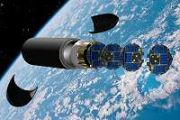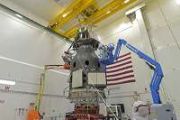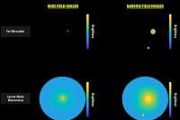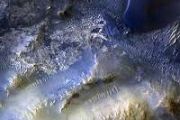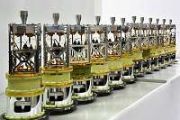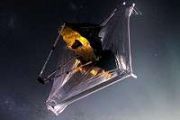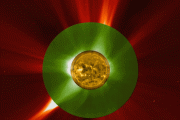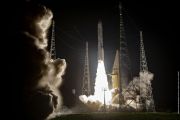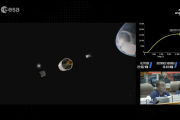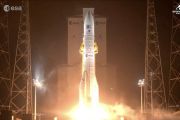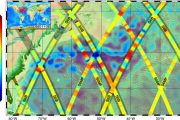
Copernical Team
What is the universe expanding into if it's already infinite?
 When you bake a loaf of bread or a batch of muffins, you put the dough into a pan. As the dough bakes in the oven, it expands into the baking pan. Any chocolate chips or blueberries in the muffin batter become farther away from each other as the muffin batter expands.
The expansion of the universe is, in some ways, similar. But this analogy gets one thing wrong - while the dough expands in
When you bake a loaf of bread or a batch of muffins, you put the dough into a pan. As the dough bakes in the oven, it expands into the baking pan. Any chocolate chips or blueberries in the muffin batter become farther away from each other as the muffin batter expands.
The expansion of the universe is, in some ways, similar. But this analogy gets one thing wrong - while the dough expands in Mercury observed in thermal infrared for the first time
 Mercury, the smallest and innermost planet in the solar system, continues to intrigue planetary researchers with its unique composition and structure, which differ significantly from Earth's Moon despite surface similarities. BepiColombo, a collaborative mission by the European Space Agency (ESA) and Japan Aerospace Exploration Agency (JAXA), aims to resolve these mysteries. Launched in 2018, th
Mercury, the smallest and innermost planet in the solar system, continues to intrigue planetary researchers with its unique composition and structure, which differ significantly from Earth's Moon despite surface similarities. BepiColombo, a collaborative mission by the European Space Agency (ESA) and Japan Aerospace Exploration Agency (JAXA), aims to resolve these mysteries. Launched in 2018, th Falsifying the role of the Anthropic Principle in Cosmology
 The Anthropic Principle (AP), first proposed by Brandon Carter in 1973, suggests that the universe is uniquely fine-tuned to support life. This idea has long sparked philosophical and scientific debates but has lacked empirical methods for validation. A recent paper in the *Journal of Cosmology and Astroparticle Physics (JCAP)*, co-authored by Nemanja Kaloper from the University of California, D
The Anthropic Principle (AP), first proposed by Brandon Carter in 1973, suggests that the universe is uniquely fine-tuned to support life. This idea has long sparked philosophical and scientific debates but has lacked empirical methods for validation. A recent paper in the *Journal of Cosmology and Astroparticle Physics (JCAP)*, co-authored by Nemanja Kaloper from the University of California, D NASA marks ten years of Hubble's Outer Planets Survey
 In 1989, NASA's Voyager mission made history by capturing humanity's first close-up glimpse of Neptune, completing its exploration of the solar system's four giant outer planets. Since their 1977 launches, the twin spacecraft, Voyager 1 and Voyager 2, revealed Jupiter, Saturn, Uranus, and Neptune to be far more intricate than scientists had previously imagined, prompting continued exploration.
In 1989, NASA's Voyager mission made history by capturing humanity's first close-up glimpse of Neptune, completing its exploration of the solar system's four giant outer planets. Since their 1977 launches, the twin spacecraft, Voyager 1 and Voyager 2, revealed Jupiter, Saturn, Uranus, and Neptune to be far more intricate than scientists had previously imagined, prompting continued exploration. Mars dust storms may be linked to warming weather patterns
 A team of planetary scientists from the University of Colorado Boulder has shed new light on the dynamics behind Mars' infamous dust storms. These events, which sometimes enshroud the entire planet in fine particles, may be triggered by warmer and sunnier conditions on the Martian surface.
Lead researcher Heshani Pieris emphasized the importance of understanding these storms for the safety
A team of planetary scientists from the University of Colorado Boulder has shed new light on the dynamics behind Mars' infamous dust storms. These events, which sometimes enshroud the entire planet in fine particles, may be triggered by warmer and sunnier conditions on the Martian surface.
Lead researcher Heshani Pieris emphasized the importance of understanding these storms for the safety MIT astronomers find the smallest asteroids ever detected in the main belt
 The asteroid that extinguished the dinosaurs is estimated to have been about 10 kilometers across. That's about as wide as Brooklyn, New York. Such a massive impactor is predicted to hit Earth rarely, once every 100 million to 500 million years.
In contrast, much smaller asteroids, about the size of a bus, can strike Earth more frequently, every few years. These "decameter" asteroids, meas
The asteroid that extinguished the dinosaurs is estimated to have been about 10 kilometers across. That's about as wide as Brooklyn, New York. Such a massive impactor is predicted to hit Earth rarely, once every 100 million to 500 million years.
In contrast, much smaller asteroids, about the size of a bus, can strike Earth more frequently, every few years. These "decameter" asteroids, meas NASA research uncovers expanding dark comet populations
 NASA researchers have announced the discovery of seven additional dark comets, celestial bodies that appear asteroid-like but exhibit cometary behavior. This finding doubles the total known count to 14 and reveals two distinct populations based on size, location, and orbital characteristics within the solar system.
NASA researchers have announced the discovery of seven additional dark comets, celestial bodies that appear asteroid-like but exhibit cometary behavior. This finding doubles the total known count to 14 and reveals two distinct populations based on size, location, and orbital characteristics within the solar system. China Long March 8A prepares for first flight in January 2025
 The Long March 8A rocket, developed to become China's primary launch vehicle for medium- and low-Earth orbit missions, is set to make its maiden flight in January 2025, as announced by the China Academy of Launch Vehicle Technology (CALT).
On Monday, the rocket was loaded onto a ship to begin its journey to the Wenchang Space Launch Site in Hainan province, South China.
"The Long Mar
The Long March 8A rocket, developed to become China's primary launch vehicle for medium- and low-Earth orbit missions, is set to make its maiden flight in January 2025, as announced by the China Academy of Launch Vehicle Technology (CALT).
On Monday, the rocket was loaded onto a ship to begin its journey to the Wenchang Space Launch Site in Hainan province, South China.
"The Long Mar TransAstra to showcase Capture Bag on ISS in 2025
 TransAstra has announced a pivotal agreement with the Center for the Advancement of Science in Space (CASIS), which manages the ISS National Lab, to conduct an in-space demonstration of its Capture Bag technology. The demonstration, scheduled for late 2025, will see CASIS covering half of the transactional costs for this mission.
This initiative highlights TransAstra's efforts to address o
TransAstra has announced a pivotal agreement with the Center for the Advancement of Science in Space (CASIS), which manages the ISS National Lab, to conduct an in-space demonstration of its Capture Bag technology. The demonstration, scheduled for late 2025, will see CASIS covering half of the transactional costs for this mission.
This initiative highlights TransAstra's efforts to address o Rocket Lab conducts hypersonic suborbital test launch for DoD
 Rocket Lab USA, Inc. (Nasdaq: RKLB) has successfully executed a suborbital hypersonic mission in November, advancing technology testing for the Department of Defense under the Multi-Service Advanced Capability Hypersonics Test Bed (MACH-TB) initiative.
The MACH-TB project, designed to enhance hypersonic flight testing capabilities, supports technology development for the United States. Thi
Rocket Lab USA, Inc. (Nasdaq: RKLB) has successfully executed a suborbital hypersonic mission in November, advancing technology testing for the Department of Defense under the Multi-Service Advanced Capability Hypersonics Test Bed (MACH-TB) initiative.
The MACH-TB project, designed to enhance hypersonic flight testing capabilities, supports technology development for the United States. Thi 



